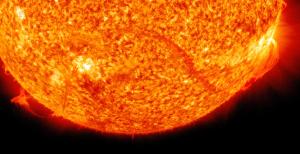An eye on the plasma edge
1 Jul 2011
-
Robert Arnoux
In terms of temperature and physical phenomena, the outer region of the plasma is "very similar to the Sun's corona," says Robin Barnsley. © Soho-Nasa/Esa
Impurities, in the form of particles detached from the machine components, will always find their way into a burning plasma. "They are unavoidable," explains Robin Barnsley, ITER Diagnostic Division Responsible Officer for spectroscopy. "It is important however, to detect and monitor them. Beyond certain limits, impurities would dilute the fusion fuel and degrade the reaction."
Impurities have different origins. Some are "expected," like the beryllium, tungsten, iron or carbon particles that come from the plasma-facing components of the machine. Others, like oxygen, copper or other metal particles, can originate from leaks or damage affecting other in-vessel components.
Because of the extremely high temperatures of the plasma, confined particles radiate light at specific wavelengths. They all have a "signature" that is both specific to their nature—beryllium will send a signal that is different from tungsten or copper—and to the temperature they are submitted to.
Identifying these signatures, and hence the nature and temperature of the particles, is the role of spectroscopy.
In ITER, several spectrometers will monitor different regions of the plasma in order to measure radiation and identify all relevant impurities. "Because of the very high temperature gradient in the plasma," explains Robin Barnsley, "light is emitted over the whole spectrum, from infrared,visible to ultra-violet and x-ray. No single spectrometer could survey the whole plasma in all those different wavelengths."
The vacuum ultra-violet (VUV) edge imaging spectrometer whose Procurement Arrangement was recently signed by ITER Director-General and the Head of the Korean Domestic Agency, is one of subsystems that, together, will monitor the ITER core, edge and divertor regions of the plasma. It is the first Procurement Arrangement to be signed for spectrometry diagnostic equipment.
The VUV edge imaging spectrometer will be looking at a region located at the upper edge of the D-shaped plasma which is typical of the outer 10% of its total volume.
The VUV edge imaging spectrometer , whose prototype is already under development and will be ready in two years, will be looking at a region located at the upper edge of the D-shaped plasma which is typical of the outer 10 percent of its total volume.
Data gathered in real-time by the VUV edge imaging spectrometer, along with that of other spectrometry devices observing other regions of the plasma, will enable the machine operators to adjust the plasma's parameters for optimal performance.
This is not the hottest part of the plasma: in terms of temperature (around one million degrees Celsius) and physical phenomena, this region is "very similar to the Sun's corona," says Robin Barnsley, who did his PhD in an X-ray astronomy group. "The physics and hence the instrumentation used for observation are closely related."
Data gathered in real-time by the VUV edge imaging spectrometer, along with that of other spectrometry devices observing other regions of the plasma, will enable the machine operators to adjust the plasma's parameters for optimal performance.



